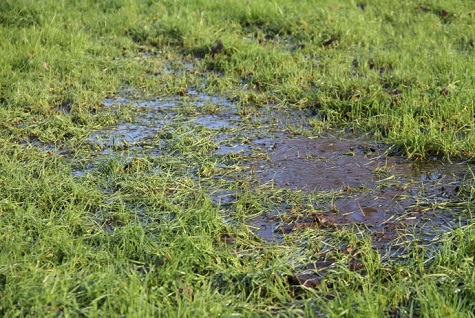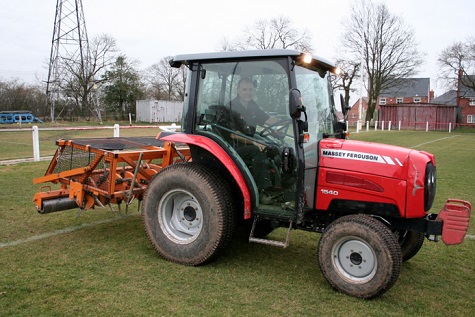This recent spell of wet weather will have certainly helped to replenish many of the rivers and lakes, and more importantly the reservoirs, we rely on for our water supplies. However, on the flip side this deluge of water will have taken its toll on many winter games pitches, particularly on heavy clay soil-based pitches.
This recent heavy rain is no doubt due to the warm temperatures we have had this summer that evaporated a lot of water into the atmosphere. Once it then becomes too heavy, gravitational forces return it back to earth in the form of rain – because as the saying goes, what goes up must come down.

Many parts of the country are reporting floods resulting from the exceptionally heavy rain. The average rainfall for November is currently at 65 mm.
All this wet weather, with more likely to come, does not bode well for turf professionals looking after soil-based sports pitches during the winter months. We have already seen several football and rugby clubs at local level postponing matches due to saturated pitches.
In many cases, these postponements could be prevented if clubs were to invest into their pitches, both during the construction phase and post construction, having a robust maintenance regime in place. However, for many natural soil-based pitches the problem is the lack of maintenance and understanding regarding the type of pitches being managed.
Knowledge and understanding of soil’s physical properties has always been important for professional turf managers when making decisions about maintenance operations and when carrying out reconstruction works. Precise soil knowledge, including information on boundaries between soil types, should result in more efficient use of fertilisers, pesticides and improved management practices. This will ensure that the final managed outputs are safe, consistent, playable natural sportsturf surfaces.
Soils can vary in many ways, both physically and chemically, on a local or regional scale. Many factors, including original parent material source, climate, weathering processes, topography or history of the land use influence their properties.

Soil particles are distinguished by their size. Most soils contain a mixture of different soil particles. The particles and the soil's structure determine the pore spaces. A soil with a high proportion of coarse sand will contain large pore spaces and drain quickly, whereas a soil having finer sand, silt or clay particles will contain smaller pore spaces, and therefore will drain more slowly.
The quantities of large and small pore spaces directly affect plant growth. On fine-texture, clay and/or compacted soils, a lack of large pore spaces restricts water and air infiltration and movement, thus limiting root growth and the activity of beneficial soil organisms. On sandy soils, the lack of small pore space limits the soil's ability to hold water and nutrients.
The strength and permeability of any soil is determined by its structure, soil type, drainage capacity and how well it is managed. Soils will perform differently, governed by the amount of water, root mass and air there is in the soil matrix.
When saturated, a soil is said to be at its maximum retentive capacity; that is, all soil pores are filled with water. Saturation usually occurs for short periods of time, generally during periods of heavy rainfall.

It is during this period we have to be mindful of how we manage and look after our soil-based pitches. If we allow play to continue while the pitch is in a saturated state, we will see the pitch prone to damage, loss of grass cover and smearing of the surface.
The heavier the soil, the longer it will take for the pitch to dry out; sandy soils are more free draining than heavy loam or clay soils and, therefore, will dry out more quickly.
Playing on saturated pitches will bring disastrous results. It is often better to postpone a fixture rather than ruin the playing surface for the rest of the season. Scrummage and line out play are the main causes of damage on rugby pitches during wet weather periods. The severity of the damage will be dependent upon the soil type and the ability of the top 100mm to drain quickly.
It is important that, once the game has finished, remedial work is carried out to repair divots and stand the grass back up. Care should be taken not to further damage the pitch by trying to get machinery on when it is wet and saturated.

A rubber rake can be used to help stand the grass back up in localised wet muddy areas; if left buried, the grass will soon die. Once this has been completed, the use of harrows/brushes can be used to stand up the sward. This is often followed by rolling back the surface using a mower or, better still, a SISIS Quadraplay unit or similar type of equipment.
Undertaking a regular aeration programme will go a long way to ensuring your pitch is able to cope during wet conditions.
Once a year you should aim to aerate to a greater depth (200-300mm) using a larger, more powerful aerator. This will help dramatically, especially if you can topdress the pitch immediately afterwards with sand, enabling this material to go down into the aeration holes.
One of the most popular pitch management tools is the Sisis Quadraplay. The Sisis Combination Implement Frames make up a single pass maintenance system which incorporates a mounted frame. The mounted frame accepts a variety of different implements for use on both turf and hard porous surfaces.

Implements such as grooming rakes, spikers, slitters, rollers and brushes can be added to the frame, making this an exceptionally versatile piece of equipment. It can be used for fine and outfield turf to perform a range of tasks so effectively that you can aerate, brush, spring tine and roll in one pass.
Using these frames before and after matches helps keep the pitch in good condition and, above all, the spiker ensures the pitch is regularly aerated. The presentation of the pitch is important. If it looks tidy and well presented, with bands and stripes, it often inspires the players to perform and, more importantly, gives them a safe, consistent surface.
Unfortunately, I see far too many club pitches that become unplayable or prone to damage, mainly due to the lack of basic maintenance being carried out and through use of equipment that is not fit for purpose. Under the Honda Rugby Grounds connect programme Honda Rugby Grounds Connected and the GMA pitch advisory services there are opportunities now available to acquire funding for new equipment and more importantly get a pitch inspection carried out by their pitch advisory services.